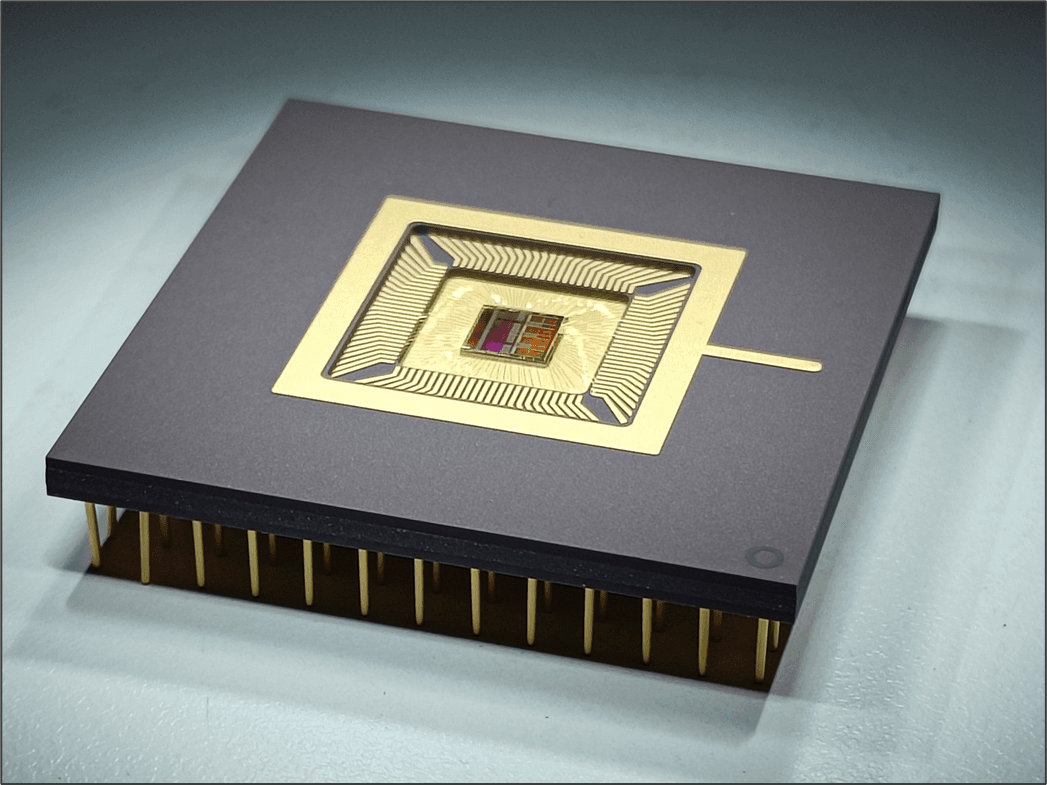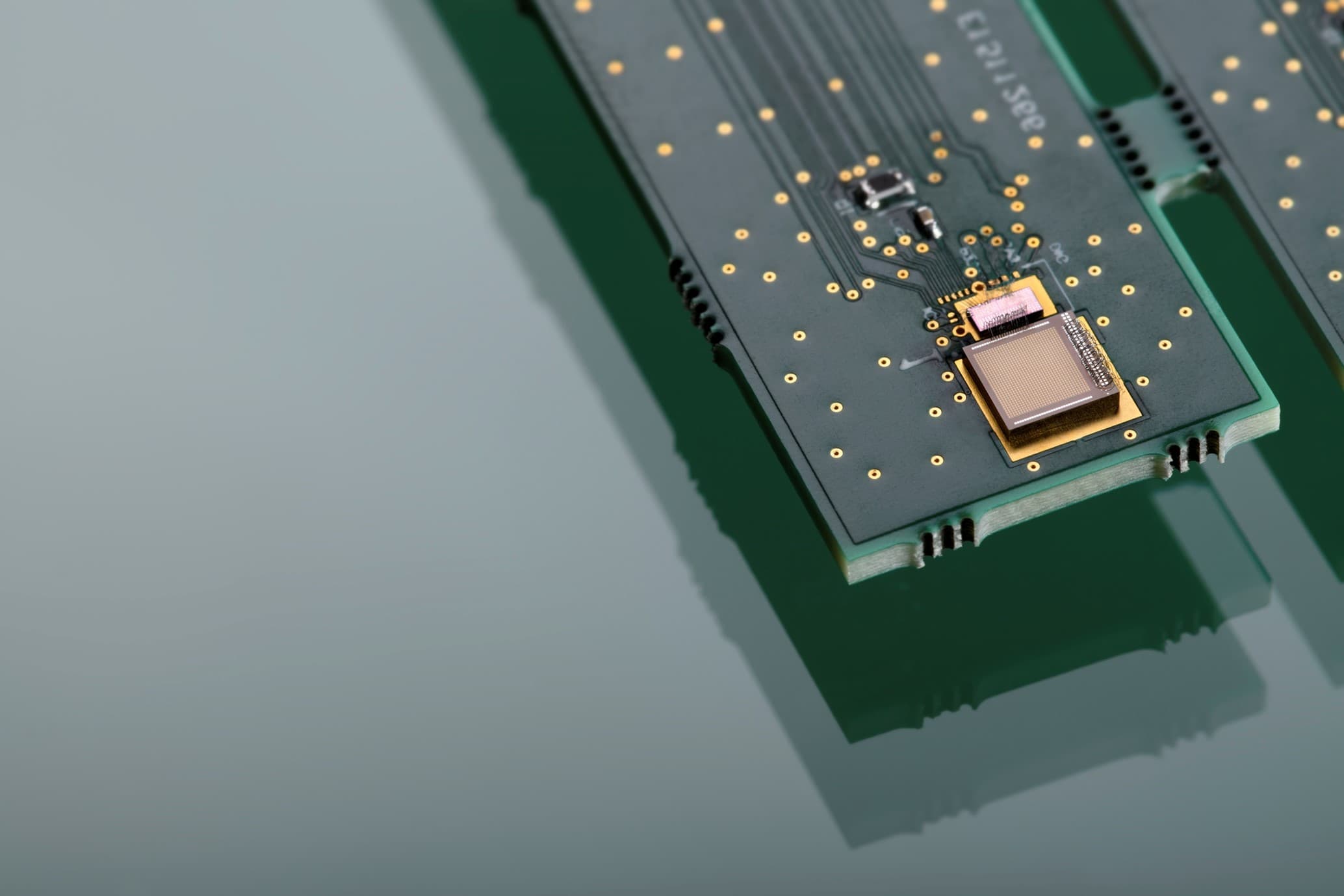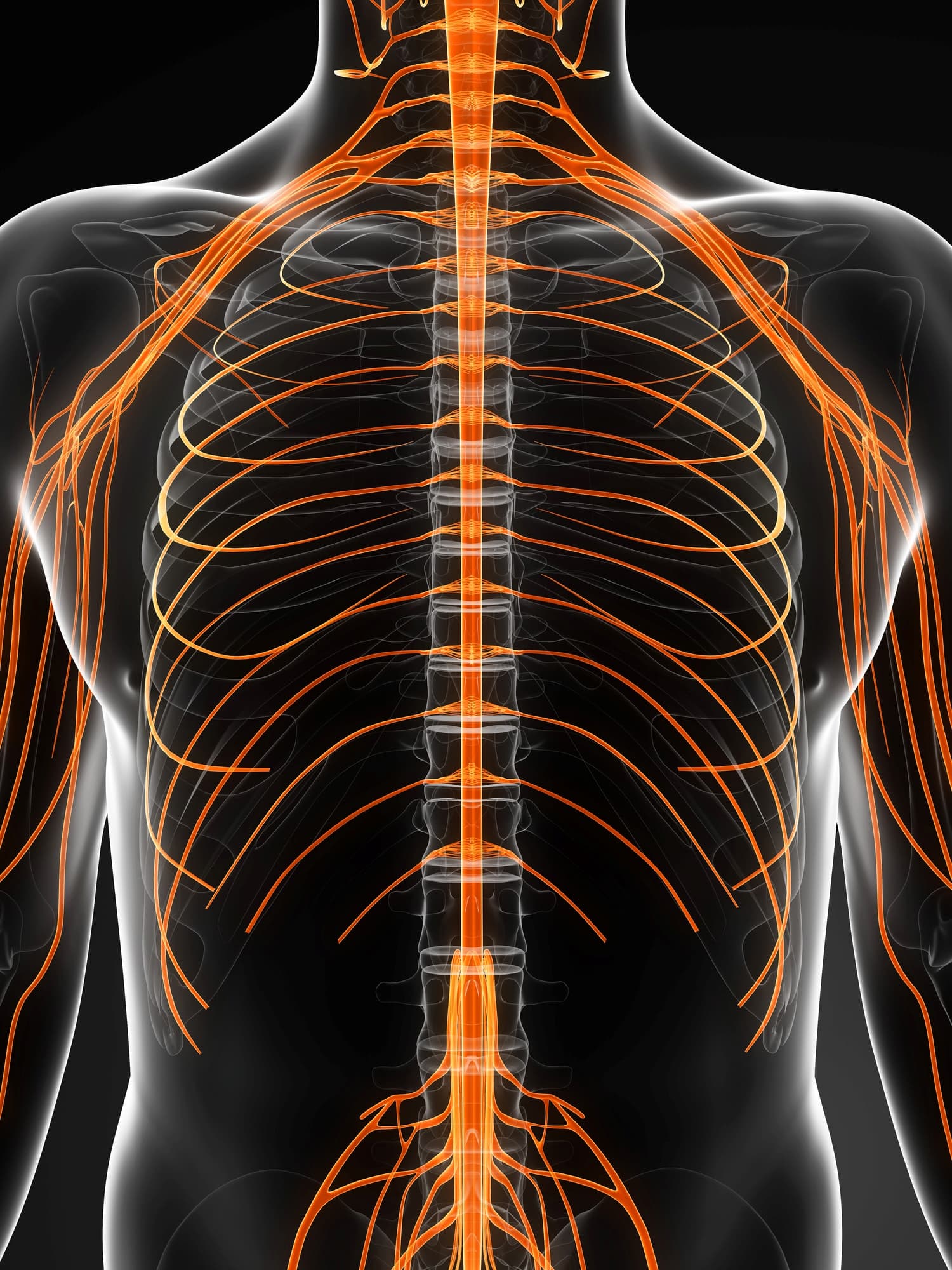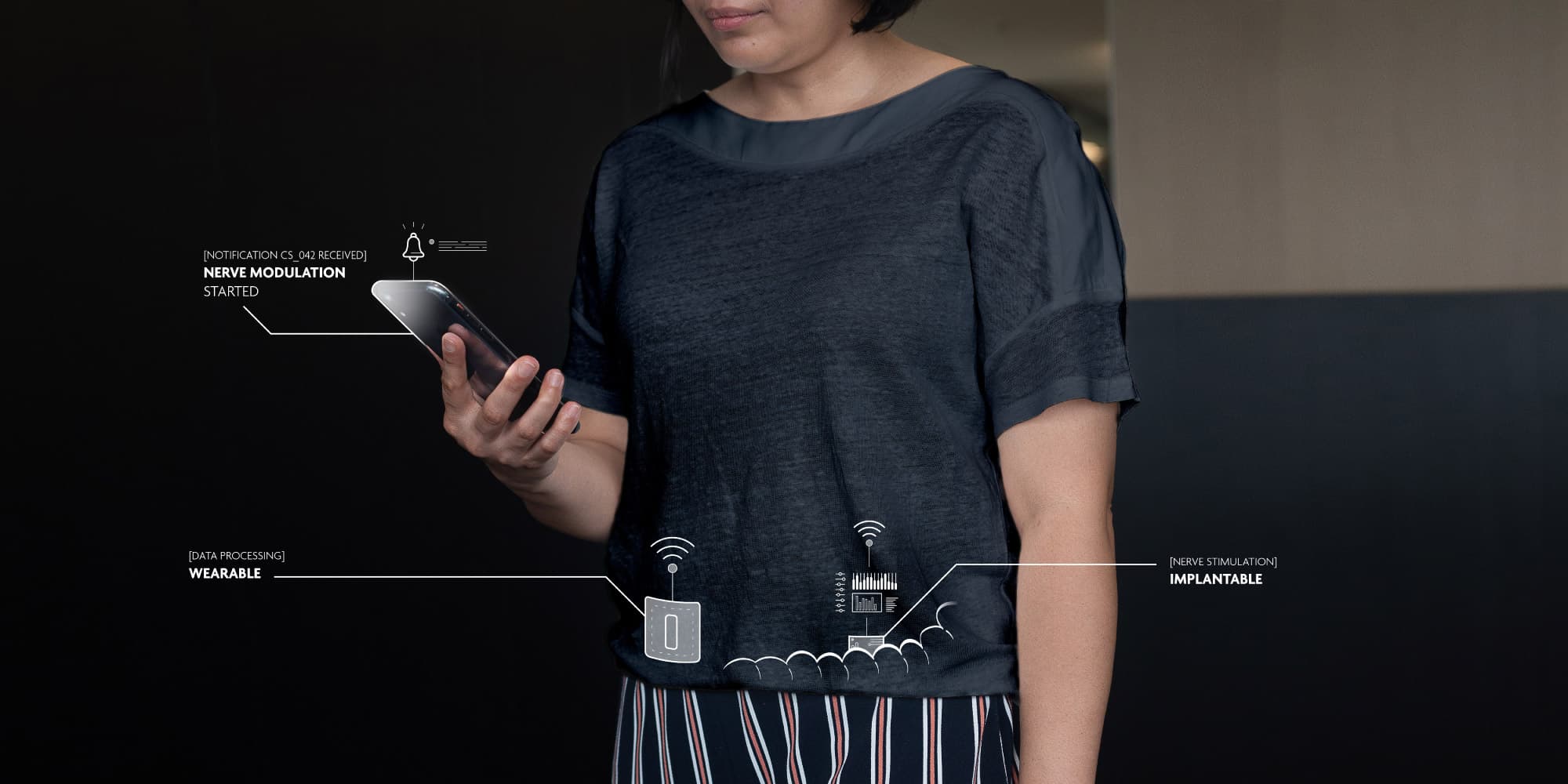In February 2020, imec presented an ultra-small radio chip at the renowned ISSCC conference in San Francisco. The chip – 30 times smaller than state-of-the-art systems performing the same functionality– can be used to set up a wireless link with e.g. smart pills, small implantables and insertables, to exchange data.
It’s only one example of the work that imec is doing in the field of implantables, insertables (e.g smart lenses), and ingestibles (e.g. smart pills). Mark Fichman, team lead medical device development, explains how such chips can be used for both communication, and for charging. The latter allows to make more user-friendly rechargeable implants or even battery-less devices.
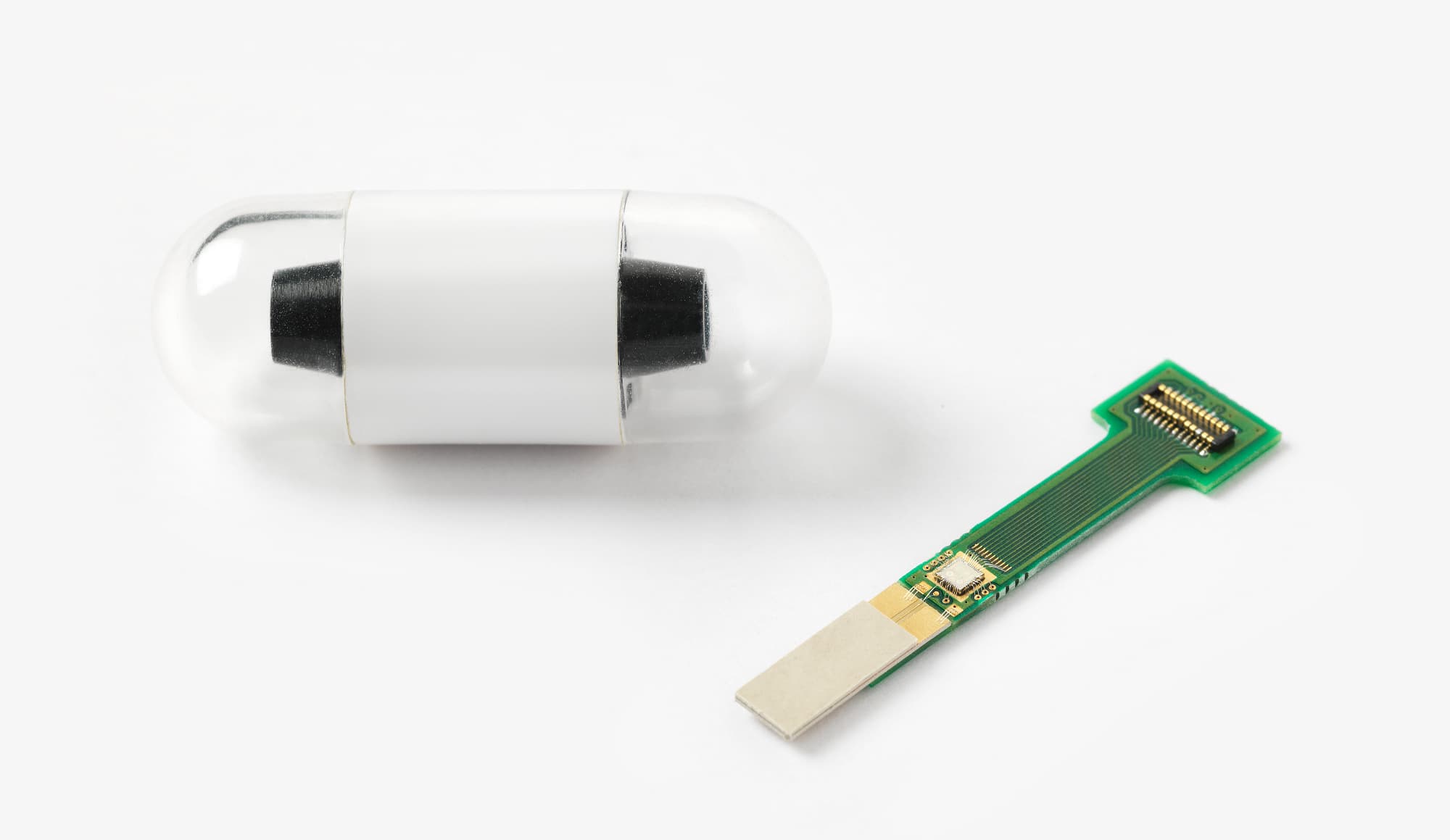
Mock-up of an ingestible pill (left) with prototype transceiver (right). The small rectangular chip is imec’s ultra-small 400MHz radio (including antenna) for communication with the ingestible. It is pictured here on a green test board.
Safety and longevity are key for implantables
Implantables, insertables and ingestibles typically consist of several building blocks: a sensing module, an actuation or stimulation module, a communication module, a power source, and – typically - a programmable component orchestrating all operations. Additionally, implantable devices require encapsulation technology to survive within the human body for long periods of time. For this, imec relies on its research group CMST at Ghent University. This group is developing a unique multicoating technology for a.o. implantables.
The requirements for all these building blocks are extremely stringent. Mark Fichman: “It’s like sending a part to space. When you implant a device, nothing can go wrong. You don’t want to put the patient through an extra surgery procedure, just because some electronic part is failing.”
“The same goes for the power source. You don’t want to operate the patient every year to replace the battery. Single-use or primary batteries are used in e.g. pacemakers. After a lifetime of 5 to 7 years, the batteries need to be replaced. But because the main pacemaker device is situated relatively close to the skin surface, this is considered a localized invasive procedure. Another small drawback is the fact that the battery is relatively large (to guarantee the long lifetime) and that the patient will ‘feel’ where it is located. A similar approach is taken for ingestibles or smart pills. Because the lifetime of the device is only one gastrointestinal cycle, primary batteries are the choice in this case.”
Other medical implants are powered by so-called secondary batteries. Mark Fichman: “These are rechargeable batteries, typically used for devices that are implanted deeper in the body, such as neurostimulators. A patient with such a device needs to recharge it, typically at home. This implies that the charger should be attached to the body for some time, up to a few hours. For some specific applications, there are also more advanced solutions available, like the charging belt for spinal cord stimulators of Boston Scientific.”
“At imec, we believe that new technologies can change the life of patients with implants. We are developing radio chips and systems for wireless communication with the implantable or insertable. These could be used to make recharging much easier and more user-friendly, or to even make devices that don’t require any battery. Also, low-power system design is an essential part of this research.”
In the latter case – the battery-less implant –, the patient would wear an external device like a patch or belt with a battery, a radio chip and an antenna that sends wireless signals to power the implanted device for a short period of time to do the necessary sensing and actuation. The implant would afterwards be depowered.
Which wireless technology to choose?
Imec has a lot of expertise in all kinds of wireless communication technologies. Mark Fichman: “We believe that every application has different requirements when it comes to wireless communications with an implant (for exchanging sensor data and actuation instructions, for reprogramming, etc.). For the wireless charging, we are investigating inductive coupling, RF signals and ultrasound technologies.”
“Inductive wireless powering is the most used technique for powering implants because the magnetic permeability of the body is almost equal to the one of air. Because of that, the path losses in the human tissues are close to insignificant. Another important advantage is the relatively large power density safety limit, up to 100mW/mm². In addition, since energy is not transferred via wave propagation, no energy is lost because of reflections by the skin and between tissues with different properties. However, inductive powering suffers from strong sensitivity to misalignment between the power transmitting coil outside the body and the implanted receiving coil. This limits its adoption to cases in which the location of the implant is known in advance.”
“Wireless powering using mid-field or far-field radio frequency electromagnetic waves on the other hand is less sensitive to misalignment. However, radio frequency power transmission suffers from significant path losses in human tissue. Additionally, safety limits are 1000 times lower. Also, since the energy transfer happens via wave propagation, significant reflection occurs already at the interface between air and skin. Finally, since the body is not a homogeneous medium, multi-path reflections will occur also inside the body, reducing further the effectiveness of this technique.”
“Wireless power transfer can also occur via mechanical means, via ultrasound pressure waves. Given that the body is mostly composed of water, the propagation of sound waves is very effective and path losses are low while the safety power limits are reasonable. The main challenge with ultrasound power transfer is the reflection coefficient between air and skin, which is as high as 99.9%. In order to mitigate this loss, good acoustic coupling must be ensured in the whole path from transmitter to receiver. This implies the use of acoustic gels and the implant must remain in close contact with the tissue in order to receive power. Even then, good acoustic coupling cannot be guaranteed throughout the body, for example due to the presence of bone tissue. So again, every application has different requirements and a different optimal technological solution.”
“Thanks to our expertise in IC design, system design and integration, it is possible to make very compact radio solutions that support different radio technologies for wireless communication and charging. For every specific application, a customized solution may work. Because we have a long track record in building radio solutions with a variety of technologies, this development can be done in a relatively short period of time. For quick iterations, we can start with discrete component-based solutions but also go all the way to make custom chips for the application”
Multiple implants tightly in synch
Making a customized solution for communicating with and charging your medical implant, has an extra, unique advantage. The radio chip, present in the patch or belt worn by the patient, can also be used to synchronize the operation of several implants in the body. This can be an extremely interesting feature for certain applications.
Mark Fichman: “Think for example of a localized stimulation that is used for pain relief in a certain part of the body. The stimulus triggers a chain reaction that passes through many neurons, both to the targeted spot and to the brain. The latter causes a typical sensation with the patient, which is a well-known side effect of this treatment. What if a second stimulation site could be used to prevent the stimulus from going all the way to the brain? This would certainly make the solution much more pleasant for the patient.”
Movie illustrating the synchronization capabilities of imec’s radio chips for – in this case – two small stimulation nodes.
Implanting a dialysis machine in the patient’s body
What if radio chips could be so small that they could be worn unobtrusively by the patient, while communicating with, charging and synchronizing the implants that the patient has inside its body?
Mark Fichman: “For sure, this innovation paves the way for many new medical solutions and treatments. Medical device companies can probably imagine what this feature could mean for their specific application. One application that imec is focusing on, is the artificial kidney. Indeed, as an active member of the Kidney Health Initiative (KHI), which (in cooperation with the FDA) is stimulating the development of technologies for future dialysis methods, imec wants to contribute to this noble goal. In fact, we even helped writing the KHI innovation roadmap.”
“We envision that our radio chips could be used in external wearables (such as patches) which main function is to communicate with and power an implanted artificial kidney (IAK). The patient would wear a patch with an integrated antenna and radio chip, attached to a small rechargeable battery. To guarantee a secure wireless link, imec develops very robust anti-hacking technology, based upon physically unclonable features (PUFs).”
“Depending on the energy consumption and internal battery of an IAK, charging of the IAK by the patch could be done intermittently, while the IAK would dialyse in a continuous way. To save on energy, the IAK can be connected between an artery and a vein, without the need for any energy-guzzling blood pumps. Instead, it would run on the body’s internal blood pressure while the artificial urine from the IAK would be dumped via the bladder in the natural way. And, by focusing on ultra-low-power system design, the internal electronics for monitoring and control would only consume very little power.”
“An IAK would be an enormous improvement compared to today’s big bed-side dialysis machines, that usually require three hospital visits per week (with 4 hours of treatment each). Dialysis patients would gain much more freedom to go where they like and when they like, just like patients with a pacemaker, or an implanted electronic nerve stimulator for pain relief.”
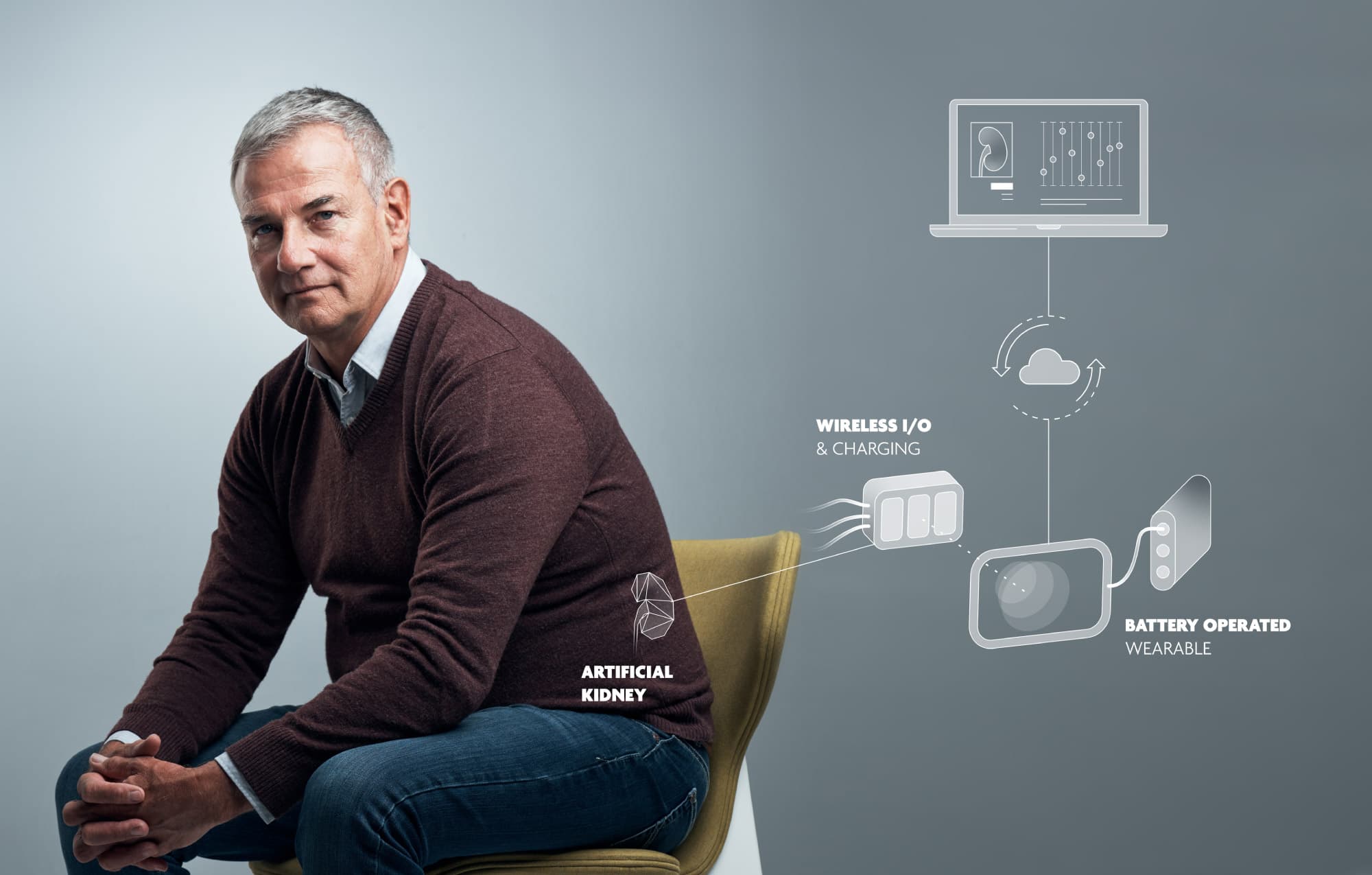
With small radio chips integrated in a patch, it would be possible to power an artificial kidney and extract its data and send it to the cloud.
Take passive implants to the next level
When thinking of implants, most of us think of pacemakers and neurostimulators. These are active devices, performing an active function inside the body, like sending out a pulse. Next to this, there are also passive implants such as screws, stents, hip replacements, stomach reduction staples etc.
Mark Fichman: “Passive devices can sizably benefit from our implantable technologies. One could add sensors or actuators to these passive devices to check for certain parameters. These ’upgraded’ implants would not need to have any batteries. Instead, they would only get activated if the patient puts an external powering device close by. Then, the sensor would wake up for a short period of time, do some sensing or actuation, and send its data to the external device.”
“Or take the example of the stomach reduction staples. By ‘smartifying’ the staples, one could get sensing info from the implanted staples. Information collected from such smart staples can be paramount in the post-surgery follow-up and through the recovery program. Because imec’s technology allows to get data from multiple sensors with respect to each other, this could provide some useful information on the functioning of the reduced stomach.”
Conclusion
Imec has a long-standing expertise in wireless radio technologies, miniaturization and design for ultra-low power consumption. These capabilities can be extremely interesting for medical device companies to innovate in the field of implantables, insertables and ingestibles. Mark Fichman: “We have an extensive toolset ready to mix and match our knowledge and our technological building blocks to make a dedicated solution for each specific application.”
“With dedicated radio-enabled external units (incorporated in a wearable, patch, belt, ...), one could readout an implanted device, send instructions, synchronize readout or activation of several devices, or power a rechargeable or battery-less (active and passive) device. The long track record of imec in the development of wearable solutions (including regulatory approved medical devices both in the US FDA and Japan’s PMDA) strengthens the system-level proposition, being able to offer both implants and external wearable solutions to power them."
“The possibilities are enormous, and, together with medical device companies with much more experience on the application-end, we can make true innovations happen. The cross-fertilization between technology and application knowledge is key in this.”
Want to know more?
- Read our white paper on ‘Technologies for next-generation implantable devices’ to learn more about the specific technologies that imec is developing for wireless charging and communication (pages 13 to 15).
- Read more about new packaging technology for implants in our reading-room article 'How to properly package an implant'
- Discuss your idea with Zohaib Gulzar, our business development manager.
- Discover the different ways of working with us.
- Get a nice overview of imec’s connected health solutions.
- Learn more about imec.

Mark Fichman is a senior engineer and team leader at imec. His background is hardware engineer and spent most of his career in the area of active implantable medical devices working for number of start-ups for 20 years now.
He is product-oriented and seeking solutions in the most challenging environments which often requires multi-discipline abilities, with extensive knowledge of standards within that area as well as for wearable devices.
Mark joined connected health solutions group at imec in 2017 and from then he leads the implantable program, working on the next-generation implantable devices intended for diagnosis and therapy.
Published on:
12 October 2020





